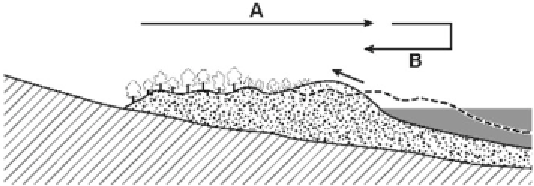Geoscience Reference
In-Depth Information
which contemporary policies fighting against coastal flooding cannot
ignore.
Figure 5.2.
Theoretical evolution of a beach over the past millennia: accumulation of
sand as a result of transgression by successive peaks a) start of the retreat b) by
onslaught of the sea due to the depletion of under-water resources [BIR 85]
These dynamic processes generate the third factor: the surges
contribute, in a most efficient way, to the phenomenon of coastal
morphogenesis. The waves batter the sediments, hit the cliffs, dislodge
matter and transport it through longshore currents which are, out of all
the existing currents, the most effective and spectacular: open-edged
sandspits are their most representative illustration. These processes
can be studied at all scales but to create useful models that are relevant
to today's issues, these models should rely on data collected on the
ground. Specialized journals (
Marine Geology, Journal of Coastal
Research,
etc.) provide a good idea of the current research being
carried out on the surf zone in terms of sediment mobility related to
the action of different types of waves and currents (tidal, rip tides,
etc.). These use technical tools that get immersed in the sea and
capture the required parameters to better understand the mechanisms
in action (current meters, sediment traps, etc.). These studies
are important as they are related to experiments aiming to counter the
effects of erosion, in particular along the large sandy shores that are
subject to tourism development.
Human development, in all its forms, has impacts at all the
geographical scales, most of these impacts being restrictive. If
possible, for now at least, let us put aside the consequences of human



Search WWH ::

Custom Search